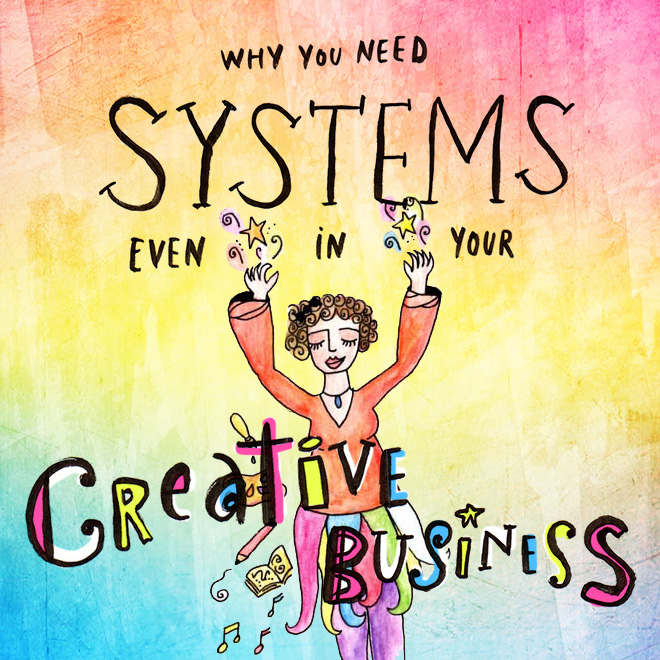
Let’s just say there’s a lady named Lily.
Lily has a little business. Always the creative type, Lily found that the images and letters flowing from her hand caught the eyes of friends and family, who began asking for her hand-written wedding invitations and greeting cards. Leaning on her art school days, she adds watercolor backgrounds on the finest papers. Face it, were God herself ever to need a little hand-drawn stationery, it isn’t difficult to imagine her ringing Lily.
This year, a friend told Lily about Leonie. Lily now finds herself at her little desk, in the upstairs of a restored Victorian, flipping through the pages of the 2016 Shining Biz Planner. It almost seemed like too much, tasking her tiny business with a whole volume of goals and commitments. It was too concrete, in a way. A little too black-and-white for a girl who loves colors. But the book had colors too and after all, there were a few details in her business that needed, well, attending to.
It wasn’t that she wasn’t good anymore at drawing or writing or watercolors. She was, is, actually, better than ever. In fact, some of her clients, now sprinkled around the world, describe opening a box of Lily’s creations as a spiritual, transcendent experience.
And it isn’t that she doesn’t love it anymore. Even though she’s written “Bride” and “Groom” thousands of times now, she still loves to watch the ink slide off the quill and lay in perfect lines over the particled paper.
It’s something else. But it is something. Some thing. Some part of this picture.
Turning the color-splashed pages of the her Workbook, she stumbles on a word that seems foreign to her hand-drawn, each-one-different world.
“Systems” it said. In big, black letters.
Something in Lily recoiled. Hers was a systems-free world. She had left systems for one-of-a-kind. She competed with systems. Faceless printers, fashioning millions of invitations using systems. Arial and Helvetica, the tools of a system. Heck, her website was hand-drawn and scanned. This was un-systems headquarters, here in the life of Lily.
Let’s leave Lily for a minute.
Maybe you’re like her. You’ve found a niche of un-system in a systems world. You’re a throwback from a different era and you like it that way. Your clients like it that way. It’s working for you.
Or, maybe you are an accidental un-systems practitioner. You didn’t set out to build a systems-free business, it just happened. You aren’t the first to find yourself in this place.
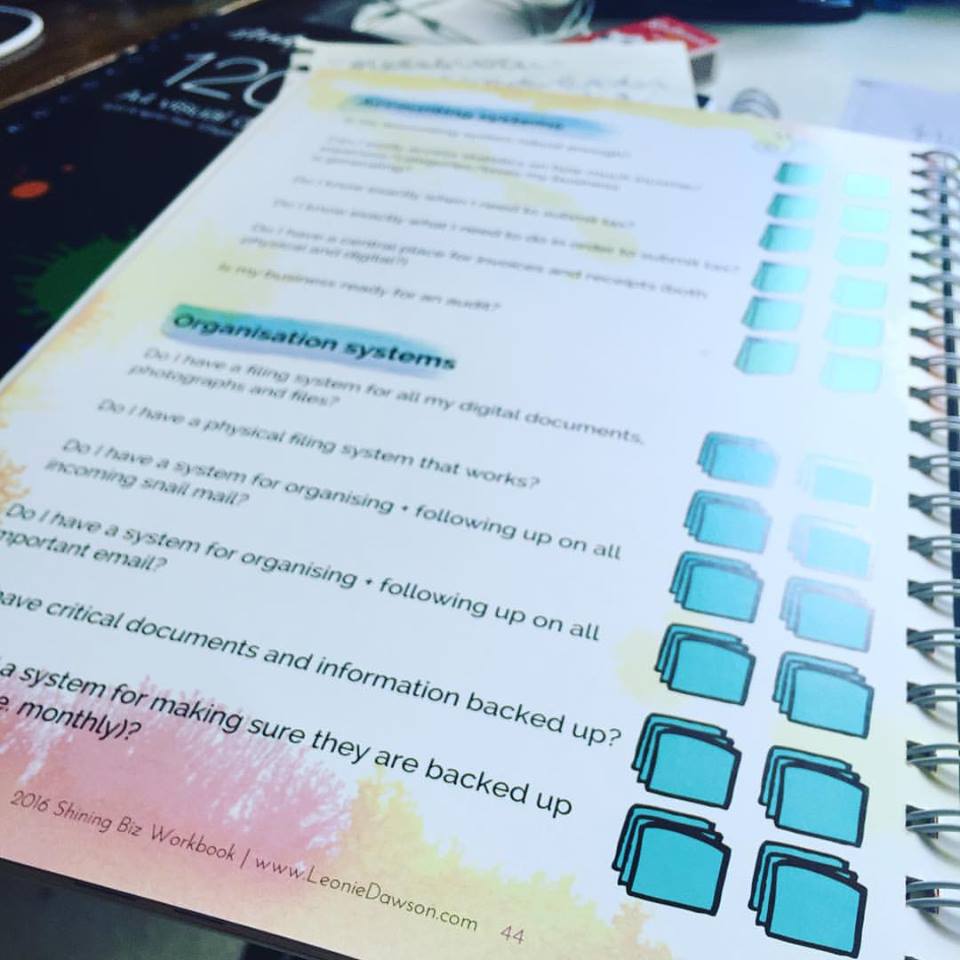
And it’s for this reason that there is a systems checklist in the 2016 Biz Goals Planner – businesses need systems. In fact, a business is really the sum of the systems that have been created. In this post, we’ll be talking about systems – what they are and how they work.
First, what ARE systems?
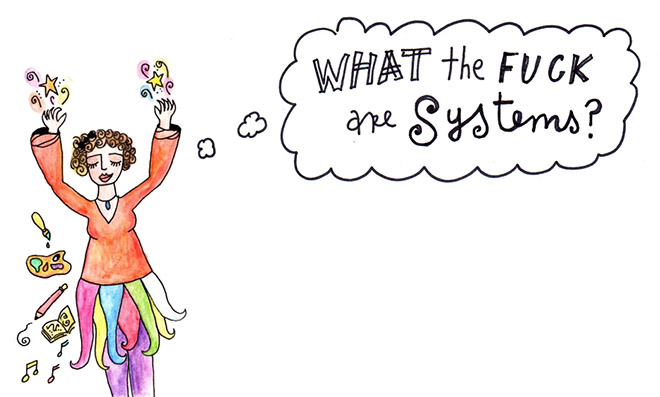
According to the Google:
systems are “a set of principles or procedures according to which something is done…”
If you think about it this way, this is any process you use to do your work.
And while it may be difficult for you, or Lily, or lots of other folks to imagine how systems could make their business lives better, that’s really the result of over-thinking. Simply put, systems are just the ways you do things.
So we all have systems for our work, right? Maybe the first time, or the first ten times you do a task, it isn’t really a system, but at some point, you have a way of doing things. So what’s the big deal?
What we’re really talking about with this focus are systems that are: identified, documented, and optimized.
We’re talking about systems that work. Systems that are intentionally tuned to create the kind of excellence your customers are hoping for.
If we drop back into Lily’s world for a minute, it’s easy to see that her passion is creating unique products, but there are lots of other pieces that aren’t all that unique or exciting. In order to lovingly lay ink on paper, there are some supplies she needs. There’s also an order taking and tracking process to know what she has been asked to make, what the deadlines are, the shipping address, and what price was quoted. There’s also the whole packing, shipping, and invoicing process. None of these aspects are the unique and exciting parts of her business. Lots of people have these problems. And most people find systems are the way to fix them.
Lily isn’t alone in thinking that her ‘whole’ business is a creative endeavor.
And early-on, it probably wasn’t so clear. When you’re doing your first work, everything is a creative, problem-solving experience. This can give you the sense that you’re just as effective and useful with a pen in your hand as you are firing off an invoice reminder to a late-paying client.
This isn’t true.
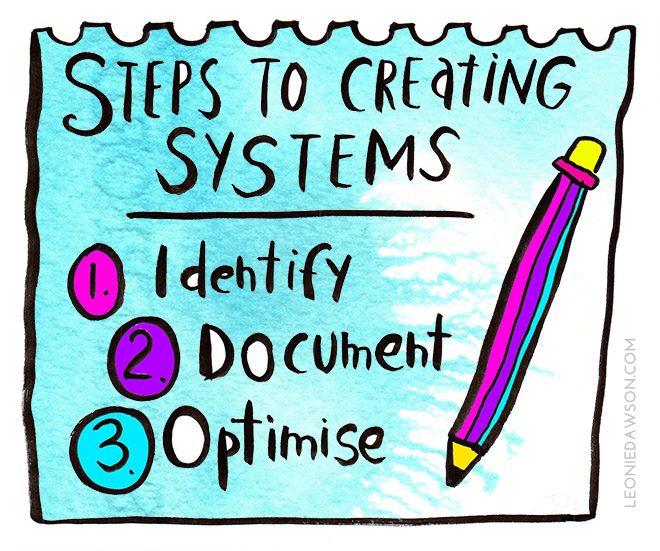
So let’s take a closer look at systems.
There are three steps to creating + keeping good systems that promote excellence in your business.
1. Identify
2. Document
3. Optimise.
I’ll go through each of these step-by-step to guide you gently through the process.
Step 1: Identify
Identifying systems provides the opportunity to hammer out the best ways to perform the vital duties of the business, then let those sit on auto-pilot most of the time, or, be ready when the business grows to be outsourced to your new assistant.
This leads us to a question – how far can we systemitize the business? How do we know where process stops and creativity starts? The answer might surprise you, but for me, the line is always a lot further toward creativity than most people want to admit. Me included.
You’ve probably heard the time-worn Aristotle quote:
“We are what we repeatedly do. Excellence, then, is not an act, but a habit.”
Let me ask you a question – what part of your business do you NOT want executed with excellence?
How many times have you been doing your work and realized that you missed a vital piece earlier in the process?
You. You who created this process. You who knows how much is riding on this order, this customer, this production. We aren’t perfect machines. Time management guru David Allen says our brains are made to focus on just one thing at a time. Any time we ask our brains for more than that, we create risk – risk we will forget, risk we will be focusing on the other thing right when we need to be focused on this thing, in short, risk of failure.
A systems-driven business will always produce a more consistent product. If you’ve put great stuff into your systems, than that consistent product will always be excellent. (Understand – McDonalds is a strict systems-driven business with consistent outcomes. As the saying goes – you can choose two of the following for your service or product: fast, cheap and good. Only two. You know which two McDonalds have chosen.)
The identification step starts with just looking at what you’re already doing. A repeated set of steps is the beginning of building this excellence. The systems checklist will give you a list of systems and processes to ensure that you have identified.
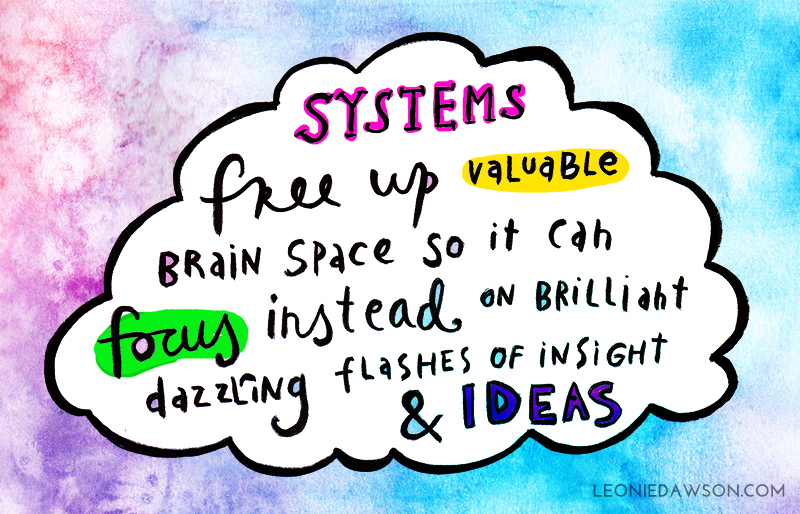
Step 2: Document
Where do we keep our systems?
How much documentation is required?
How often should we update our processes and check on our systems?
The answer to all of these questions is really basic – in ways that make sense. Again, this is an area ripe for over-thinking. And lots of people have created tools to help you over-think. Don’t get sucked in!!
In one of my first jobs where I was introduced to these concepts, my system was a series of processes printed and in a binder. Each week, as I did my work, I opened the binder, turned to the process I was going to do, and followed the numbered list. This ensured that I was on-track and doing my work thoroughly each time.
There are electronic tools, paper tools, it doesn’t matter when you’re using. Do what feels good.
Just make sure you’ll use it. (There’s an awesome new Academy course on Standard Operating Procedures that will get you started on this path!!)
How often should you update your systems, processes, and documentation?
Well, it seems to me the obvious answer is whenever things change. Which means, you need a process to remind you to update things so that your overall system is self-updating. In my binder, for instance, the last step of every process was:
“Have there been any changes to this process? If so, please cross through and write the new instructions.”
The last sheet in the book was a task I did on Fridays – I would take the prior sheets, look for updates, make them in the computer, highlight them as I updated the originals, then print a new set of procedures and file the old ones. This ensured that the documentation aspect was maintained as part of my role.
**Side-note: sometimes I see people looking for someone to create their systems and processes for them. Help me do this. Help is good, but there’s a trap here. Hiring someone to do all of this once is a recipe for disaster. Your systems must be continually changing to reflect the very best of what you’re doing – and that means that they must be updated by someone very close to the work, ideally the person doing the work is updating the processes to keep the whole system together.
Step 3: Optimize
Now that you’ve identified and documented each step of each process in all your systems, new possibility is in the air.
This is a great example of the old axiom “make it work, then make it better.” You can improve your processes two ways – one, by recognizing when things break, change, or need improvement, and two, by dedicating some time to brainstorming and collecting ideas for improving a particular area and then implementing these changes intentionally. Both work and both are needed.
The most important part is not to miss the chance to make things better.
Documented systems become objects you can make choices about and changes to… this is just one reason why it’s so much better to have things on paper instead of inside your head.
Keep forgetting things and realizing it later in the process? Change your documentation to make sure that step doesn’t get skipped.
Realize that certain kinds of orders aren’t being completed on-time because the process takes longer? Document the different times to deliver in your quoting process so that you set proper expectations up-front.
Missing vital tax and accounting information when you visit the accountant? Figure it out and edit your receipt and data collection processes to ensure you can show up with everything in order.
This is where the magic lives.
Systems aren’t things that bind us and corrupt our creativity. They are a giant playground for our creativity.
How can we build THE-VERY-BEST-OF-EVERYTHING into our processes? How can we ensure that customers are ALWAYS SATISFIED? How can we make sure that even when we’re busy, we still do our best work?
By building our best work into systems and then following them.
So back to Lily.
Here she is, sitting at her one-of-a-kind desk, in her I-restored-this-myself Victorian house, sitting beneath the glow of her only-one-in-London desklamp. And suddenly she realizes that it isn’t ‘how’ she does her work that makes it special.
The special ingredient isn’t the process, it is the person.
What she has been missing comes clear. It’s all the stuff that isn’t about beautiful lines on paper. It’s the orders, the getting back to people, the invoicing and the shipping. It is all the parts that she struggles to see as creative. It’s the business her creativity sits in that is lacking. She’s been so focused on her own work and skills, she missed building an infrastructure as solid and reliable as her work.
The word ‘Systems’ on the page suddenly has a different hue. It isn’t bondage, it is freedom. It is freedom from the tyranny of memory. The never-ending sensation that you’re forgetting something. (Often brought on by the fact that you are…)
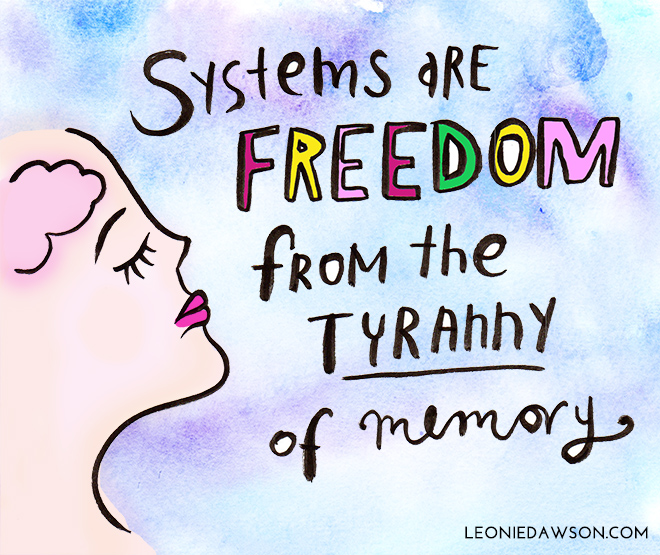
Lily is energized. This is a task she can do.
She can put her mind to work on the best ways to handle all these aspects of her business that don’t involve her special gift. She envisions clarifying the best ways to handle communication, making those order-pads she keeps thinking about, setting up the invoicing system that she noticed online the other day.
Drudgery is replaced by the knowledge that when this work is moving, she can have a business that is beautiful from start to finish. A business that is excellent from top to bottom. A business that supports and deserves a talent as big as hers. Something beautiful for something beautiful.

I hope you find yourself in Lily a bit.
I hope you see that the unique piece you bring to the world needs systems that are as great as you. Don’t let the beauty of your creations be tarnished by the simple, nearly generic processes of business. Use the systems checklist in the 2016 Biz Goals Workbook to make sure you have systems in place in every area of your business.
Identify, document, and optimize the work that supports your gift to the world.
Your work is worth it. You’re worth it.
Big love,

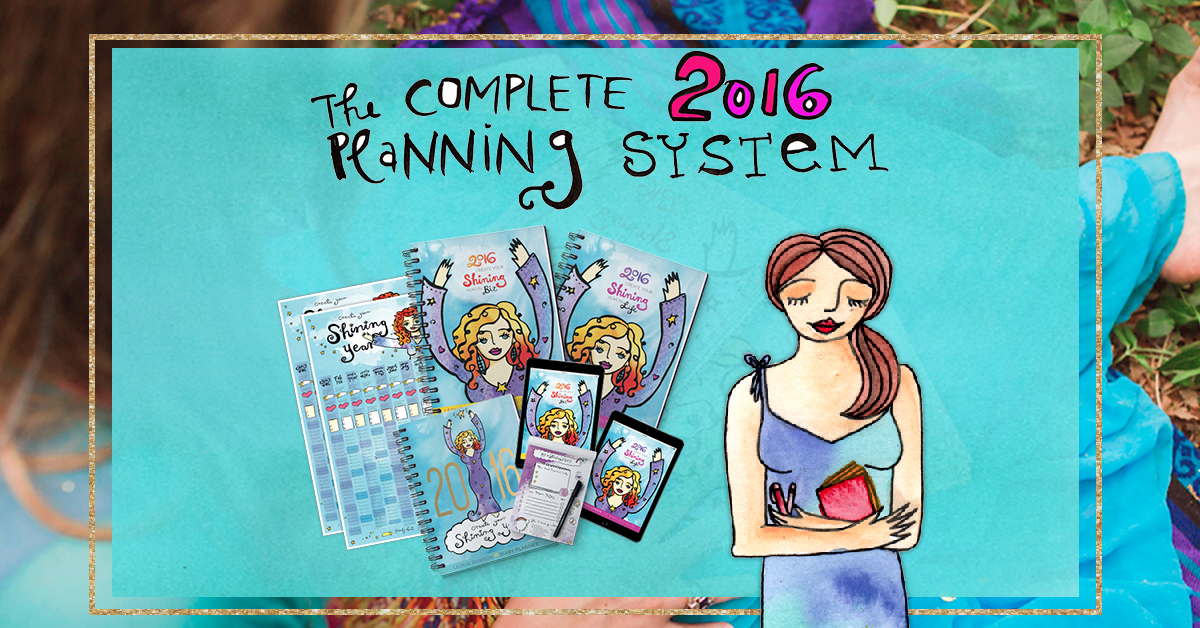
YOU MAY ALSO LOVE…
[leonie_show_posts ids=”24421,22921,25385,12864″]











